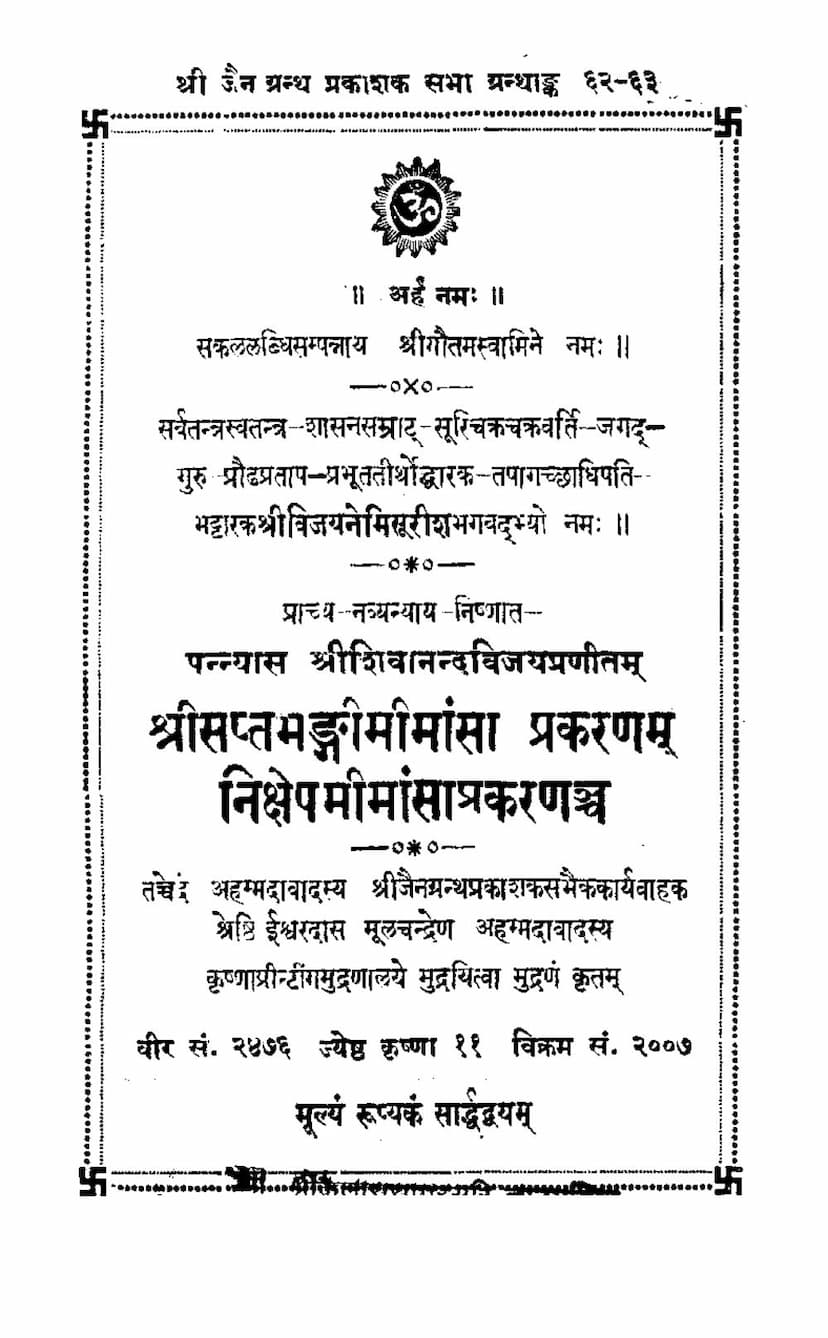Saptabhangimimansa
Added to library: September 2, 2025

Summary
This summary is based on the provided Jain text, focusing on the book "Saptabhangimimansa" by Shivanandvijay.
Book Title: Saptabhangimimansa (and Nikshep Mimamsa) Author: Shivanandvijay Publisher: Jain Granth Prakashak Sabha
This comprehensive work delves into two fundamental concepts of Jain philosophy: Saptabhangi (The Seven-fold Syllogism) and Nikshep Mimamsa (An Exposition on Classification/Placement).
I. Saptabhangi Mimamsa (Exposition on the Seven-fold Syllogism):
The text extensively explains the Saptabhangi doctrine, a core principle in Jain epistemology that addresses the complexity and multi-faceted nature of reality. It asserts that any given object can be described from seven different perspectives, acknowledging that reality is not absolute but relative to the point of view.
-
The Essence of Saptabhangi: The book explains that Saptabhangi involves stating a proposition using the word "Syat" (possibly/perhaps) seven times, each representing a different facet of truth. This avoids one-sided or absolute judgments, recognizing that an object possesses multiple, sometimes seemingly contradictory, qualities simultaneously.
-
The Seven Perspectives (Bhangas): The text elaborates on each of the seven perspectives:
- Syadasti: Possibly it exists (from one point of view).
- Syannasti: Possibly it does not exist (from another point of view).
- Syadasti Nashasti: Possibly it exists and does not exist (simultaneously, from different points of view).
- Syadvaktavya: Possibly it is indescribable (due to the inherent complexity or paradox).
- Syadasti Avaktavya: Possibly it exists and is indescribable.
- Syannasti Avaktavya: Possibly it does not exist and is indescribable.
- Syadasti Nashasti Avaktavya: Possibly it exists, does not exist, and is indescribable.
-
Purpose and Significance: Shivanandvijay highlights the crucial role of Saptabhangi in understanding Jain philosophy, particularly in refuting extreme viewpoints (like nihilism or absolutism) and establishing the doctrine of Anekantavada (Many-sidedness of Reality). The text argues that Saptabhangi is essential for accurate knowledge, providing a balanced and comprehensive understanding of any subject.
-
Methodology: The author explains that Saptabhangi is applied by considering different aspects or attributes of an object. Each "Bhanga" (perspective) is justified through logical reasoning and references to established Jain texts and the teachings of previous āchāryas (scholars). The book aims to synthesize the views of various traditional scholars on Saptabhangi, making it accessible in one place for the benefit of scholars.
-
Broader Applicability: The text demonstrates how Saptabhangi can be applied not only to metaphysical concepts but also to practical and philosophical discussions, illustrating its relevance in philosophical debate and discourse.
II. Nikshep Mimamsa (Exposition on Classification/Placement):
This section of the book delves into the concept of Nikshep, a classificatory system crucial for understanding how concepts and entities are defined and understood within the Jain tradition.
-
The Four Niksheps: The text details the four types of Nikshep:
- Nam Nikshep: Classification by name.
- Stapana Nikshep: Classification by representation or establishment (e.g., an idol representing a deity).
- Dravya Nikshep: Classification by substance or substratum.
- Bhava Nikshep: Classification by state or quality.
-
Role and Importance: Shivanandvijay explains that Nikshep is essential for accurate understanding and communication. By correctly classifying things under these four categories, one can avoid confusion and gain a precise grasp of the subject matter. It helps in distinguishing between the name of something, its representation, its underlying substance, and its actual state or quality.
-
Interrelation with Other Concepts: The book discusses the relationship between Nikshep, Pramana (means of valid knowledge), and Naya (standpoint or perspective). It shows how Nikshep is intricately linked to these concepts and how a proper understanding of Nikshep contributes to the validity of knowledge derived from Pramanas and Nayas.
-
Scholarly Debate: The author engages with different interpretations and debates surrounding Nikshep among Jain scholars, presenting various viewpoints and offering his own analysis. He emphasizes the importance of understanding these classifications to grasp the nuances of Jain logic and metaphysics.
Overall Significance of the Work:
"Saptabhangimimansa" and "Nikshep Mimamsa" are presented as rigorous philosophical treatises that systematically explore and explain complex Jain doctrines. The work is characterized by:
- Deep Scholarly Engagement: The author demonstrates a profound understanding of Jain logic and philosophy, drawing upon a wide range of scriptural sources and the works of eminent āchāryas.
- Clarity and Method: Despite the intricate nature of the topics, Shivanandvijay strives for clarity, explaining the concepts in a structured and methodical manner, often employing the framework of Navya Nyaya (New Logic).
- Defense of Jain Philosophy: The book serves as a defense and elucidation of Jain principles, particularly Anekantavada and the nuances of epistemology, against opposing philosophical views.
- Preservation of Tradition: By delving into these foundational concepts, the work contributes to the preservation and propagation of Jain philosophical heritage.
The book is dedicated to the revered Guru, Bhattarakacharya Shrimad Vijay Nemisurishwarji Maharajshri, and highlights the lineage and teachings of prominent scholars within the tradition, such as Shri Udayamurishwarji and Shri Nandanmurishwarji. The preface by Amrutlal Mohanlal Sanghi further underscores the intellectual depth and importance of the work.